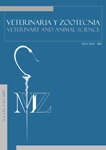Authors
Abstract
ABSTRACT: In intensive farming of rainbow trout (Oncorhynchus mykiss), which is the second most important fish species in Colombian aquaculture, only female alevines stocking is recommended since, because of tropical conditions, males present sexual precocity and use high percentage nutrients in sperm formation, decreasing growth, presenting more aggressiveness and therefore causing continuous attacks and injuries to females, which negatively affect the profitability of trout farms. For these reasons, this research evaluated the efficiency of gynogenesis in only female alevines production and their effect in growth. This technique is based on the exclusive transfer of genetic information from the mother, since the paternal genome is inactivated by irradiation with ultraviolet light (UV), prior to fertilization and the thermal shock eggs are put down which favors the retention of the second polar body during the second mitosis thus producing diploid alevines.
From the above reasons, the present research proposed to determine the optimal 27 °C thermal shock exposure time for eggs in terms of higher percentage of females and better zootechnical parameters, during hatchery. The study showed that the highest percentage of gynogenetic fish was obtained in treatment 4 (27 °C thermal shock during 15 minutes), which reported statistical differences (p<0.05) compared to the other treatments, in the studied variables including weight and height increment, simple growth rate and survival.
Keywords
References
Chavez-Lomeli, M.O.; Mattheeuws, A.E.; Pérez, M.H. Biología de los peces del río San Pedro en vistas a determinar su potencial para la piscicultura. 1 ed. INIREBFUCTD. Xalapa, Veracruz, México.222 p. 1989.
Chourrout, D & Quillet, E. Induced gynogenesis in the rainbow trout: sex and survival of progenies production of all - triploid populations. Theor Appl Genet. n.63, p.201–205. 1982.
Chourrout, D. Use of grayling sperm (Thimallusthimallus) as a marker for the production of gynogenetic rainbow trout (Salmogairdneri).Theor Appl Genet. n.72, p.633-636.1986.
Chourrout, D. Genetic manipulations in fish: Review of methods. Francia, EIFAC/FAO. Symposium Bordeaux. 27 - 30 may. 1987.
Diter, A.; Quillet, E.; Chourrout, D. Supression of first egg mitosis induced by heat shock in the rainbow trout. Journal of FISH BIOLOGY. v.42, n.5, p.777-786, 1993.
Grizzle, J.M. & Rogers, W.A. Anatomy and histology of the channel catfish. Auburn Pinting Inc., Auburn University, Agr. Exptl. Station: 94p. 1976.
Huerta, B.M. Inactivación genética de esperma de cabrilla arenera Paralabrax maculato fasciastus (Steindachnert, 1868) utilizando luz UV. Mazatlán, Sinaloa, México: 89p. 1999. Tesis (Tesis de maestría Centro de Investigación en Alimentación y Desarrollo). Hoar, W. & Randall, D. Fish physiology. Academic Press. Orlando, USA. 1969. 465 p.
Landines, M.; Daza. P.; Sanabria, A. (Eds). Mecanismos celulares de la reproducción de los peces. In: Reproducción de peces en el trópico. Instituto Colombiano de Desarrollo Rural. INCODER. Bogotá, D.C., Colombia. Primera edición. 246p. 2005.
López-Macías, J.; Portillo-Gómez, N. & Ramos-Ramos, A. Efecto de la temperatura en el porcentaje de hembras de trucha arcoiris (Oncorhynchus mykiss) obtenidas mediante ginogénesis. In: XXXIII Congreso nacional de ciencias biológicas. Memorias… Universidad del Tolima. Ibagué, Colombia. 1998. 222p.
López-Macías, J.; Mena, P.; Rodríguez, J. et al. Evaluación de inmunoestimulantes en las fases de levante y ceba de trucha arcoiris (O. mykiss) cultivada en jaulas flotantes en el lago Guamuez. Informe Final de Investigación. Vicerrectoría de Investigaciones Postgrados y Relaciones Internacionales. Universidad de Nariño, Pasto. Colombia, 2005, p278.
Purdom, C.E. Radiation-induced gynogenesis and androgenesis in fish. Heredity. n.24, p.431-444. 1969.
Salinas, J. Aplicación y optimización de técnicas de gynogenésis en trucha arcoiris. Bogotá, Colombia: Universidad Nacional de Colombia, 1991. 67p. Tesis (Facultad de Zootecnia).
Shelton, W.L.; Rodriguez, G.D.; López, M.J. Factors affecting androgen sex reversal of Tilapia áurea. Aquaculture. v.25, n.1, p.59- 65, 1981.
Thorgaard, G.H. Chromosome set manipulation and sex control in fish. In: Fish Physiology. v. 9, part B. (W. S. Hoar, D. J. Randall and E. M. Donaldson, eds). 405-434p. Academic press, New York. 477p. 1983.
Urbinati. E. Bases fisiológicas de la reproducción en peces tropicales 23-42 p. 2005.

 PDF (Español)
PDF (Español)
 FLIP
FLIP










